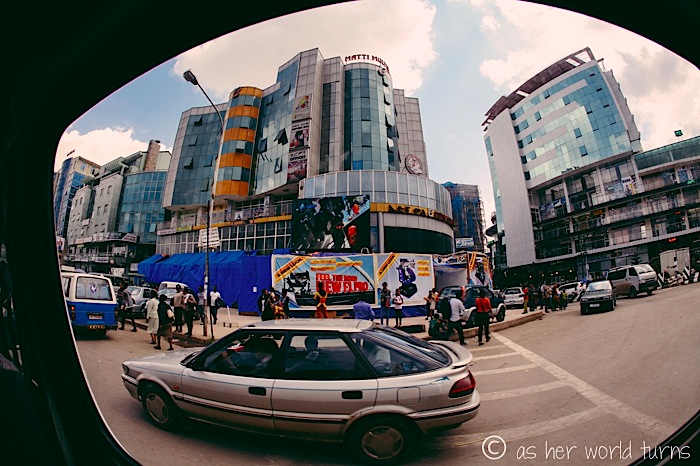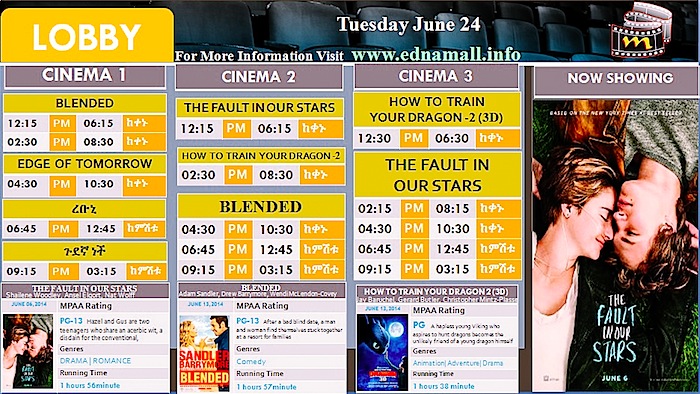Today is not a typical photo-heavy post, but rather a story.
As I wrote yesterday, Ethiopia feels like a whole different universe. I am the only white face in a sea of dark-skinned countenances, an awkward island sticking out like a blight on an otherwise cohesive landscape. But on my second day in the capital city, I find a way to blend into that sea. I go to the movies.
Going to the movies — or to the theater, for that matter — is a shared experience. Everyone is literally on the same side (of the screen) as we ride the highs and lows of the story together, laughing at jokes and perhaps shedding a tear or two during more sober moments. For those two hours, we are one audience regardless of our background, united as a witness to this particular cinematic experience.
As a fan of the book, I’d been eager to see The Fault in our Stars in theaters– going as far as to add the sneak preview to my calendar the night before I left for Africa on June 6th. Really, in what dream world do I live in prior to a big trip like this? Of course I was far too swamped packing to go to the movies. I was bummed to miss it, so when I find out the local ‘mall’ (term used loosely) in Addis Ababa plays English movies and THIS film is currently screening, it becomes a priority on my second day in Ethiopia.
I walk about 35 minutes to the Edna Mall, located inside this building below (I snap the photo a few days later on a cab ride to the airport).

A quick note about the graphic below: there are two times listed for each screening, one in the left column and one in the right column. This is because time is different in Ethiopia… are you ready to have your mind blown? While the day I see the movie is June 24th, 2014 in the rest of the world, it’s 2006 in Ethiopia and they are in the 10th out of 13 months in the year, and there’s a six-hour time difference between their local time and actual international time (“because we’re below the equator,” a taxi driver tells me, as if that explains everything). So in the chart below, the 12:15p screening of The Fault in our Stars represents the international time (i.e. the time in Ethiopia according to my iPhone) which is really 6:15 for the locals. Every time someone tells me the time or I see it posted somewhere, I’m momentarily confused before I remember that there’s two different ways to measure time and dates here.

So I show up for the movie 90 minutes early and purchase a ticket. Then I find a cafe nearby where I order a latte and chicken dish. I ask for the wifi password but the waitress tells me it only works in the morning. The latte — sweet elixir of my dreams — is so delicious that I ask for another, but I’m told they ran out. Okay then.

I go back to the movie theater, where I’m told they only open the doors five minutes before the screening is scheduled to begin. This is unfortunate because we’ve all been given assigned seats like it’s the Arclight and there are actual ushers to escort us inside. This of course takes longer than five minutes (there’s a huge crowd of people and like four ushers) so suddenly the lights go down and the one preview begins (22 Jump Street) as people struggle to find their seats in the dark.
Observation: lots of people get (plain) popcorn and soda, but almost no one buys the candy available for sale. I don’t get anything as years of watching movies at the DGA theater in LA has made me a purist (or a snob) — I focus 100% of my attention on the film without the distractions of food or rustling candy wrappers.
Going into the theater, I’d gotten lots of stares as the obvious single white face in a crowd of Ethiopians, the irony being that we were about to watch a nearly all-white movie that features a single actor of color in a small role. (An African American actress plays a doctor with, like, five lines in an early scene — Hollywood, do better. Really.) Other than those two minutes, this crowd of Ethiopians doesn’t see themselves reflected back at all in this mainstream movie; it’s entirely about another culture. If the list of films currently screening at this theater is any indication, most movies here fall into this category. It reminds me of a quote by the esteemed author (and Pulitzer Prize winner) Junot Diaz — if you want to turn a human being into a monster, deny that person any cultural reflections of themselves in books, TV, movies. To see an image of you — of your people — looking back at you, is validation that you EXIST, that there is a value in telling stories about people like you. It’s problematic that so many cultural groups even within the U.S. are underrepresented in media; Junot Diaz says it’s his mission to “put up a couple of mirrors” during his time on Earth, and so far he’s created an entire hall of them with his best-selling novels. When you consider the dominant position Hollywood holds in the spectrum of world entertainment, it’s sort of unnerving to think about the abundance of films that represent American culture which are then marketed to audiences around the globe. Granted, Ethiopia doesn’t exactly have its own thriving movie industry to churn out comedies and dramas featuring its people (and frankly, the country has more pressing matters to address, like poverty, or the daily wide-spread power outages), but it’s unsettling to consider that citizens of this country and many others like it are offered a limited range of predominantly Western entertainment. This isn’t meant to come off as a scholarly assessment, just a tangent of thoughts floating through my mind as I sit in a theater with 200 Ethiopians watching a film about my own culture.
I digress. Back to The Fault in our Stars.
The movie is in English with both French and Amharic (the main Ethiopian language) subtitles. Some jokes get bigger laughs than others and it’s neat to see which lines land with this particular crowd. If you know anything about this movie or book, it’s an unabashed tear-jerker — it’s about teenagers dying of cancer. As tears slip down my face (I’m holding back sobs), I hear sniffling all around me. It’s very much a communal experience as we literally laugh and cry together, despite the fact that this movie reflects a very different culture than that of the country in which we’re watching it. The power of Hollywood — and author John Green — has astonishing reach in this world, something I knew in the abstract prior to this experience but which now plainly presents itself before me.
Funny moment: during the film’s single sex scene, a parent drags their small child out of the theater amidst laughs from other movie goers.
With about 12 minutes remaining — all of us deeply emotionally invested at this point — the power cuts out and we find ourselves sitting in total darkness. Power outages are frequent occurrences so it’s hardly unexpected, but still a major bummer. Some people leave since we’re so close to the end of the movie, but the rest of us stick it out and ten minutes later the power is restored and they cue up to the scene where we left off.
Since moving to Los Angeles I’ve become accustomed to sitting through the entirety of a film’s credits. (Exception: when the DGA theater is packed and I know I’m doomed to a 20-minute wait to exit that parking garage if I don’t high-tail it out of there.) I love watching the full credits because invariably I recognize names of friends or acquaintances who worked on the project, even if I had no idea they were affiliated with that particular film. And that is so cool! Case in point: last year in Australia I saw The Heat in theaters, that cop buddy flick with Melissa McCarthy and Sandra Bullock, and a friend from college who I haven’t seen in nearly a decade was one of the location managers. I messaged him on Facebook as soon as I got back to my hostel to say hi and how neat it was to see his name in the credits half-way around the world.
All of this is to say that I am bummed when the movie theater in Ethiopia stops the projector just as the technical credits (post-actors) begins to roll. Oh well… I am clearly the only person in the theater still looking at the screen. For half a second I consider calling out, “Wait, maybe I know some of these people!”
And that is the story of the time I went to a movie theater in Ethiopia.







This is one of my favorite posts. Thanks for sharing the beautiful weirdness of travel.
Thank you, Erica. I’d been looking forward to sharing this story. And your ‘beautiful weirdness’ travel descriptor is so apt!
Thank you so much for your blogs on Ethiopia. Our daughter is doing research this summer in a village a distance from Arba Minch. She is alone but does have a college educated interpreter from the village working with her. Communication has been quite sketchy as I’m sure you understand. Your blog has helped us understand what she is dealing with. Best wishes to you in your travels. Deb & Brad Bader
Debra & Brad, I am so glad to hear that the blog posts were helpful. I hope your daughter is enjoying her research in Ethiopia; it’s a fascinating place to experience as it’s so different from our own culture. Thank you for the comment!